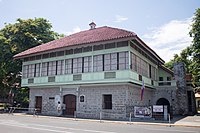Bahay na Bato

A bahay na bato is a type of house that was common in the Philippines during the Spanish colonial era. It is made of stones and bricks, and has a wooden frame and roof. The stones and bricks are arranged in a specific pattern to make the house strong and durable.
The bahay na bato is usually raised off the ground and has a wide staircase leading up to the front door. There are large windows that let in lots of light and air, and the roof is steeply sloped to allow rainwater to run off easily.
Inside, the bahay na bato is divided into different rooms using wooden partitions. There is usually a sala, which is the living room, and a dining room. The bedrooms are located at the back of the house, and there is also a kitchen and a bathroom.
People in the Philippines used to live in bahay na bato houses because they were sturdy and provided protection from the weather and from intruders. They were also beautiful and reflected the Spanish colonial influence in the country's architecture.
Today, there are still some bahay na bato houses that are preserved as historical landmarks or converted into museums. They are an important part of the Philippines' cultural heritage and continue to inspire modern architects and designers.
The bahay na bato is usually raised off the ground and has a wide staircase leading up to the front door. There are large windows that let in lots of light and air, and the roof is steeply sloped to allow rainwater to run off easily.
Inside, the bahay na bato is divided into different rooms using wooden partitions. There is usually a sala, which is the living room, and a dining room. The bedrooms are located at the back of the house, and there is also a kitchen and a bathroom.
People in the Philippines used to live in bahay na bato houses because they were sturdy and provided protection from the weather and from intruders. They were also beautiful and reflected the Spanish colonial influence in the country's architecture.
Today, there are still some bahay na bato houses that are preserved as historical landmarks or converted into museums. They are an important part of the Philippines' cultural heritage and continue to inspire modern architects and designers.
Related topics others have asked about:
Ancestral houses of the Philippines,
Architecture of the Philippines,
Bahay kubo,
Colonial architecture of Southeast Asia,
Culture of the Philippines,
Earthquake Baroque,
History of the Philippines (1565–1898),
Malay houses,
Rumah adat,
Shophouse,
Sino-Portuguese architecture,
Spanish Colonial architecture
